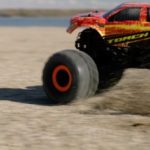Honda Demos Prototype Autonomous Work Vehicle for Airfield Operations
This IS the Droid You’re Looking For
Honda today demonstrated its fully-electric prototype Honda Autonomous Work Vehicle (AWV) at the Toronto Pearson Airport to promote the next stage of development – engaging airfield operators and airport authorities in field testing the AWV at their worksites. Today’s demonstration of a first-of-its kind autonomous perimeter fence inspection solution showed how the Honda AWV could be used to address the challenges of labor shortages, safety and security, and emissions reductions to bring new value to airfield operations.
The demonstration was conducted in collaboration with the Greater Toronto Airports Authority, along with technology leaders including Cisco Canada, Genwave Technologies, Illuminex AI and Eagle Aerospace.
First introduced by Honda as a concept at CES 2018, the Autonomous Work Vehicle is now advancing toward commercialization and Honda is inviting interested companies to email AWV@na.honda.com for more information about participating in the field testing initiative.
“Our Honda Autonomous Work Vehicle has been verified to help improve worksite efficiencies and safety through previous field tests, so we’re ready to move to the next stage of exploring real world applications with airfield operators,” said Jason VanBuren, systems engineering manager at American Honda Motor Co., Inc. “As we work toward commercializing the Honda AWV, we want to understand the needs of airfield operators and airport authorities to create new value by streamlining operations, enhancing safety performance and helping to meet airfield environmental sustainability goals.”

The Honda Autonomous Work Vehicle is designed to boost workforce productivity and support repetitive tasks that allow companies to focus their workforce on value-added activities. It is a fully electric, off-road vehicle that can be operated autonomously or manually with a remote control. Using Honda’s software system on a tablet-based interface, the operator can develop routes for the AWV to move around the worksite by setting start and stop points or creating a map of the worksite.
Haul, Attach and Tow: Honda AWV Use Cases
As a mobility platform, the Honda AWV can haul materials, attach or carry functional equipment such as sensors or a camera, and tow a maintenance tool or trailer.

For the Toronto Pearson Airport demonstration, Honda showcased a first-of-its kind autonomous perimeter fence inspection solution that leverages the AWV’s mapping and obstacle detection features – enabling the AWV to effortlessly navigate inspection routes and slow down or stop to avoid colliding with an obstacle.
The proof of concept perimeter fence inspection integrates technologies from multiple tech companies, a collaboration that successfully shows what is possible when leveraging advanced technologies for airfield perimeter security. The following technologies were applied to the Honda Autonomous Work Vehicle:

Cisco Ultra Reliable Wireless Backhaul is the wireless networking backbone that provides reliable, secure and private connectivity to the airfield.
Genwave Technologies designs, integrates, and supports wireless networks such as Cisco’s IoT Ultra Reliable Wireless Backhaul platform.
Illuminex AI’s Operational AI System provides real-time assessments of airfield conditions and alerts of potential hazards.
Eagle Aerospace’s AIROps™ cloud-based software enables real-time automated logging of discrepancies during the inspection process.
Honda is exploring other use cases for the AWV to enhance efficiencies of airfield and airport ground operations. For example, the Honda AWV could haul and transport aircraft parts and equipment, and workers could attach a mower to the AWV for vegetation control around airfields as well as a FOD (foreign object debris) tool to remove debris from airport runways and aprons. To help streamline airport ground support, the Honda AWV could tow a baggage cart or trailer to and from aircraft.

The Honda AWV uses a camera for real-time monitoring and a suite of sensors to operate autonomously, including GPS for location and radar and LiDAR for obstacle detection. Honda has field tested the Autonomous Work Vehicle at several worksites, where the vehicle successfully transported supplies to pre-set destinations within the work site along a calculated route and proved capable of stopping within centimeters of pre-set points. It also was able to detect obstacles and other vehicles in its path to ensure a safe interaction with workers.

COMPANY DETAILS |

|
|
Company |
Honda Automotive |
|
Website |
|
|
Connect |
   
|
|
|
|
|
Contact |
|
|
Phone |
(800) 999-1009 |
|
Address |
1919 Torrance Blvd. |
|
Torrance, CA 90501 |
ABOUT Honda Automotive®
Founded in 1948 in Hamamatsu, Japan, Honda opened its first U.S. storefront in Los Angeles, CA, in 1959. What began as a nimble operation with eight industrious associates would quickly grow to astounding heights. For nearly four decades Honda has challenged to exceed government requirements – as the first automaker to meet the Clean Air Act standards in the 1970s, then demonstrating low-emissions vehicle technology that led the state of California to adopt new, more stringent emissions regulations.







